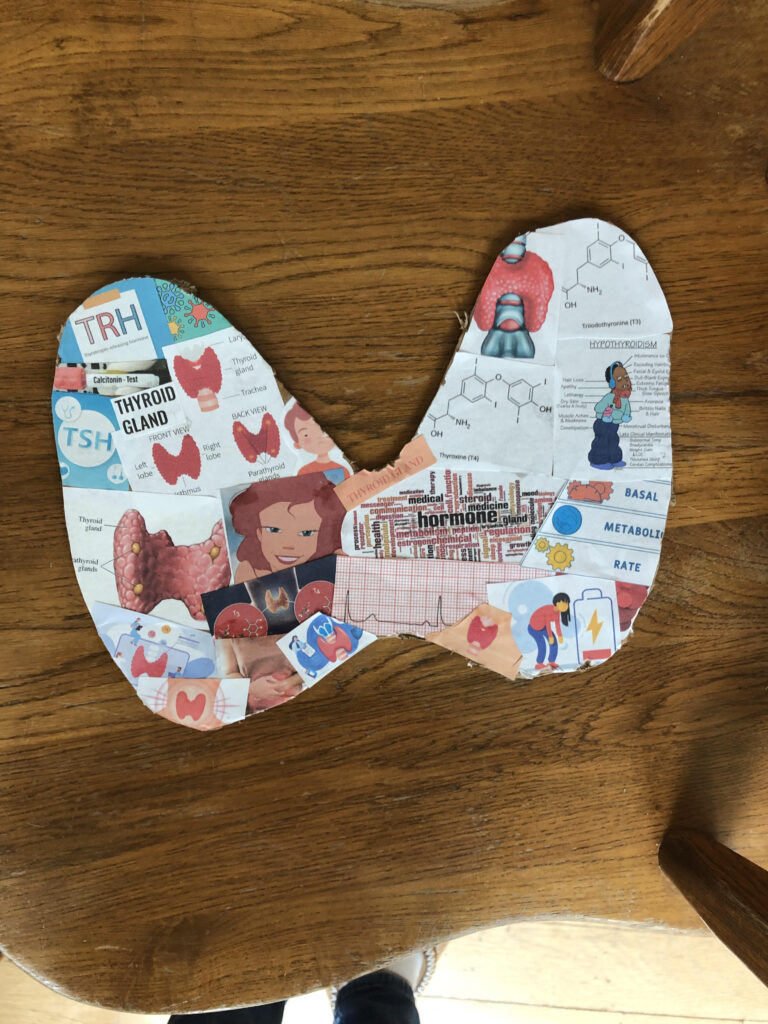
The main hormones produced by the thyroid gland are thyroxine or tetraiodothyronine also known as T4, and triiodothyronine, known as T3. Thyrotropin-releasing hormone, known as TRH, is from the hypothalamus. Thyroid-stimulating hormone or TSH is from the anterior pituitary gland. The thyroid gland produces calcitonin, which is made by C-cells and is involved in calcium and bone metabolism. It reduces blood Ca2+ levels. T3 and T4 increase the basal metabolic rate, making all of the cells in the body work harder. They raise body temperature and create a faster pulse and a stronger heartbeat. In children, they help with brain maturity and growth promotion. They help activate the nervous system which leads to improved concentration and faster reflexes.
The chemical class of thyroxine and triiodothyronine is an amine. The chemical class of calcitonin is a peptide. Iodine is a trace element absorbed in the small intestine. It is an important part of T3 and T4, a decrease in Iodine can lead to a decrease in thyroid hormone synthesis, which can lead to hypothyroidism.
On the cellular level, the regulation of the thyroid hormone starts at the hypothalamus. The hypothalamus releases thyrotropin-releasing hormone into the hypothalamic-hypophyseal portal system to the anterior pituitary gland. Then thyrotropin-releasing hormone stimulates thyrotropin cells in the anterior pituitary to release the thyroid-stimulating hormone. Thyroid-stimulating hormone is eventually released into the blood and binds to the thyroid-releasing hormone receptor on the basolateral aspect of the thyroid follicular cell. Where eventually, the five steps of thyroid synthesis happen, which are the synthesis of thyroglobulin, iodine uptake, iodination of thyroglobulin, storage, and finally the release of the thyroid hormones.
The function of the thyroid hormones is to increase basal metabolic rate, induce lipolysis or lipid synthesis, stimulate the metabolism of carbohydrates, anabolism of proteins, permissive effect on catecholamines, in children growth hormone to stimulate bone growth, during the prenatal period maturation of the brain, and in adults, it affects mood. The thyroid hormone affects fertility, ovulation, and menstruation.
Hypothyroidism is a disease of the thyroid. Hypothyroidism is caused by an underactive thyroid gland. It is decreased basal metabolic rate which can present as apathy, slowed cognition, dry skin, alopecia, increased low-density lipoproteins, and increased triglycerides. Hypothyroidism can only be ruled out in psychiatry patients which present apathy and slowed cognition. It can decrease sympathetic activity and lead to decreased sweating, bradycardia, and constipation. Some people with hypothyroidism can have myxedema which is caused by decreased clearance of complex glycosaminoglycans and hyaluronic acids from the reticular layer of the dermis. Symptoms of hypothyroidism include bradycardia, fatigue, cold intolerance, weight gain, poor appetite, hair loss, cold and dry skin, constipation, myopathy, stiffness, cramps, entrapment syndromes, and delayed deep tendon reflex relaxation. In primary hypothyroidism, there is a decreased production of thyroid hormones by the thyroid gland which causes an increase in thyroid-stimulating hormone. Secondary hypothyroidism is caused by pituitary disorder which causes a decrease in thyroid-stimulating hormone release and decreased T3 and T4 levels. The third hypothyroidism is caused by hypothalamic disorders which results in decreased thyroid-releasing hormone levels, thyroid-stimulating hormone, T3 and T4 levels.
Overall, the thyroid hormones are calcitonin, thyroxine T4, and triiodothyronine T3. The other hormones that are involved in the thyroid gland, but not from the thyroid are thyroid-releasing hormone TRH and thyroid-stimulating hormone TSH. Hypothyroidism is one of many diseases that are caused by the thyroid gland.
Works Cited
Shahid, M. A., & Sharma, S. (2019). Physiology, Thyroid Hormone. Nih.gov; StatPearls Publishing. https://www.ncbi.nlm.nih.gov/books/NBK500006/
NCBI. (2018, April 19). How Does the Thyroid Gland work? Nih.gov; Institute for Quality and Efficiency in Health Care (IQWiG). https://www.ncbi.nlm.nih.gov/books/NBK279388/
lumen learning. (2019). Hormones | Anatomy and Physiology II. Lumenlearning.com. https://courses.lumenlearning.com/suny-ap2/chapter/hormones/

Maddie completed her STEAM project on the thyroid gland hormones. Maddie starts by listing tetraiodothyronine or T4 and triiodothyronine or T3 as the main hormones secreted by the thyroid gland. She also states thyrotropin releasing hormone (TRH), secreted by the hypothalamus, and thyroid stimulating hormone (TSH), secreted by the anterior pituitary gland, are produced to stimulate the thyroid which then releases the thyroid hormones. It is stated that T3 and T4 are classified as an amine while calcitonin is a peptide. Iodine is then discussed as a trace element essential to T3 and T4 production and when iodine levels are too low the risk of hypothyroidism is increased. From Maddie we learn that they hypothalamus secretes thyrotropin releasing hormones which stimulates the pituitary to secrete thyroid stimulating hormone which reaches the thyroid and binds to the thyroid follicular cells. Thyroid synthesis of thyroid hormones then occurs following a five-step process. Now that we know what goes occurs on a molecular level, we then learn about the function of the thyroid hormones and the effects of hypothyroidism. The thyroid provides many functions in the body ranging from metabolic rate, stimulation of bone growth in children, our moods in adulthood, and fertility. These are just a few of the many function the thyroid provides. Lastly, hypothyroidism is a disease caused by an underactive thyroid gland which can be the result of thyroid issues, pituitary issues, or issues with the hypothalamus. Hypothyroidism effects many functions within the body and can affect things like external appearance, metabolic functions, and even our moods. Maddie also provided a visual piece that depicts everything she discussed in her research paper. From her visual you gain learn about things like the shape of the thyroid and its location along with the chemical make-up of T3 and T4.